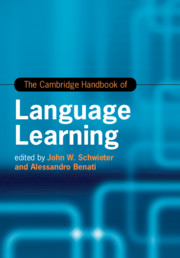Book contents
- The Cambridge Handbook of Language Learning
- Cambridge Handbooks in Language and Linguistics
- The Cambridge Handbook of Language Learning
- Copyright page
- Contents
- Figures
- Tables
- Contributors
- Acknowledgements
- Introduction
- Part I Theories
- Part II Methods
- Part III Skill Development
- Part IV Individual Differences
- Part V Pedagogical Interventions and Approaches
- 20 Pedagogical Interventions to L2 Grammar Instruction
- 21 Task-Based Language Learning
- 22 Task and Syllabus Design for Morphologically Complex Languages
- 23 Proficiency Guidelines and Frameworks
- 24 Technology-Mediated Language Learning
- 25 Content-Based L2 Teaching
- 26 Conceptions of L2 Learning in Critical Language Pedagogy
- Part VI Context and Environment
- Part VII Moving Forward
- Index
- References
22 - Task and Syllabus Design for Morphologically Complex Languages
from Part V - Pedagogical Interventions and Approaches
Published online by Cambridge University Press: 25 June 2019
- The Cambridge Handbook of Language Learning
- Cambridge Handbooks in Language and Linguistics
- The Cambridge Handbook of Language Learning
- Copyright page
- Contents
- Figures
- Tables
- Contributors
- Acknowledgements
- Introduction
- Part I Theories
- Part II Methods
- Part III Skill Development
- Part IV Individual Differences
- Part V Pedagogical Interventions and Approaches
- 20 Pedagogical Interventions to L2 Grammar Instruction
- 21 Task-Based Language Learning
- 22 Task and Syllabus Design for Morphologically Complex Languages
- 23 Proficiency Guidelines and Frameworks
- 24 Technology-Mediated Language Learning
- 25 Content-Based L2 Teaching
- 26 Conceptions of L2 Learning in Critical Language Pedagogy
- Part VI Context and Environment
- Part VII Moving Forward
- Index
- References
Summary
Like planes that after thousands of hours of careful engineering design can successfully take us to our destination, task design for second or foreign language (L2) use and learning should be able to take learners who do not know or have not mastered a language to successfully and appropriately communicating in it. In this chapter, we reflect on how task design may be carried out when second languages are morphologically complex.
The goals of task design are manifold, and most L2 task designers and researchers would agree on the following facts: firstly, task design should guarantee that the pedagogic tasks used in a classroom slowly but steadily approximate L2 learners to real-life performance (see for example the concept of “target tasks” in Long, 2005; 2015). Secondly, while maintaining a focus on meaning, task goals, and task completion, task design should facilitate the conditions for language processing and language learning to take place through focus on form (Doughty & Williams, 1998; Doughty, 2001), and hence guarantee exposure to rich and meaningful input, the provision of opportunities for interaction, production, and feedback (Gass & Mackey, 2007).
- Type
- Chapter
- Information
- The Cambridge Handbook of Language Learning , pp. 527 - 549Publisher: Cambridge University PressPrint publication year: 2019
References
- 2
- Cited by

